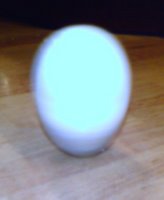 Lagom till Påsk hittas i Nature News en artikel om hoppande ägg. Det är en version om den kända paradoxen om varför ett ägg som snurras med symmetriaxeln horisontellt reser sig på högkant om ägget snurrar tillräckligt fort. Experiment utförda på parkettgolvet hemma hos föräldrarna (se bild) visar att detta är en realitet. Det till synes paradoxala består i att ägget, när det reser sig på högkant, faktiskt ökar sin potentiella energi, precis som den berömda tippe-toppen som vänder upp-och-ner när man snurrar den. Lösningen till ägg-problemet publicerades i Nature1 lagom till påsk så sent som 2002. Det är friktionen som är viktig. Om friktionen är för låg eller så hög att ägget snurrar utan att glida kommer det inte att ställa sig upp. Artikeln ger en ekvation som beskriver villkor för att "gyroskopisk balans" skall uppnås. T ex måste ägget rotera med större hastighet än ca 10 rpm.
Lagom till Påsk hittas i Nature News en artikel om hoppande ägg. Det är en version om den kända paradoxen om varför ett ägg som snurras med symmetriaxeln horisontellt reser sig på högkant om ägget snurrar tillräckligt fort. Experiment utförda på parkettgolvet hemma hos föräldrarna (se bild) visar att detta är en realitet. Det till synes paradoxala består i att ägget, när det reser sig på högkant, faktiskt ökar sin potentiella energi, precis som den berömda tippe-toppen som vänder upp-och-ner när man snurrar den. Lösningen till ägg-problemet publicerades i Nature1 lagom till påsk så sent som 2002. Det är friktionen som är viktig. Om friktionen är för låg eller så hög att ägget snurrar utan att glida kommer det inte att ställa sig upp. Artikeln ger en ekvation som beskriver villkor för att "gyroskopisk balans" skall uppnås. T ex måste ägget rotera med större hastighet än ca 10 rpm.Men, man kom också till en annan slutsats, att stigningen till stående position inte sker som en mjuk rörelse, utan ryckigt. Om ägget snurrades tillräckligt fort skulle kanske denna ryckiga rörelse få ägget att hoppa. An grupp japanska forskare satte igång att undersöka fenomenet. De byggde upp en maskin som kan snurra ägget på ett mycket välbestämt vis, bland annat för att sökerställa att det inte var uppåtrörelser från snurrningen som kanske skulle få ägget att hoppa. Först började de att testa med att snurra ett aluminiumägg. När "ägget" snurrades med 1500 rpm började det hoppa. Hoppen var små, endast någon tiondels millimeter höga och varade bara några millisekunder. Genom detektion med höghastighetskamera kunde man konstatera att det förutspådda hoppandet faktiskt skedde. För säkerhets skull dubbelkollade man med hjälp av en mikrofon som uppfattade ljudet av det hoppande ägget, och man mätte skillnaden i kapacitans när metallägget lämnade metallbordet. Naturligtvis genomförde man också mätningarna med ett riktigt, hårdkokt ägg. Vid 1800 rpm lyckades man få även det att hoppa. Eller som man skriver i sitt abstract:
Simultaneous three-way observation of optical, acoustic and electric properties demonstrates a theoretical prediction that a spinning prolate spheroid can spontaneously lose contact with the table in the course of its rising motion when the contact friction is weak and the spin is large enough. The durations of the first loss of contact are measured for various initial spin rates and for three aspect ratios. The measurements show good agreements with numerical simulations. It is also visually shown that a spinning hard-boiled egg can jump.Fantastikt! En film (som min dator vägrar spela) finns också här (8 MB). Och folk hävdar att fysiker inte sysslar med viktiga saker...
1 Nature 416, 385-386 Classical dynamics: Spinning eggs — a paradox resolved

Uppenbar fråga: går det att uppnå samma fenomen med ett rått ägg?
SvaraRaderaI slutet av den teoretiska artikeln nämns:
SvaraRadera"Finally, we may note that a raw egg does not rise when spun, simply because the angular velocity imparted to the shell must diffuse into the fluid interior; this process dissipates most of the initial kinetic energy imparted to the egg, the remaining energy being insufficient for condition (14) to be satisfied and for the state of gyroscopic balance to be established."
Experimentalisterna verkar dock oförskräckta:
"Now the researchers hope to investigate whether jumping also happens for raw eggs, where the motion is complicated by the sloshing about of the liquid yolk"
Fortsättning kanske följer påsken 2008 eller så...